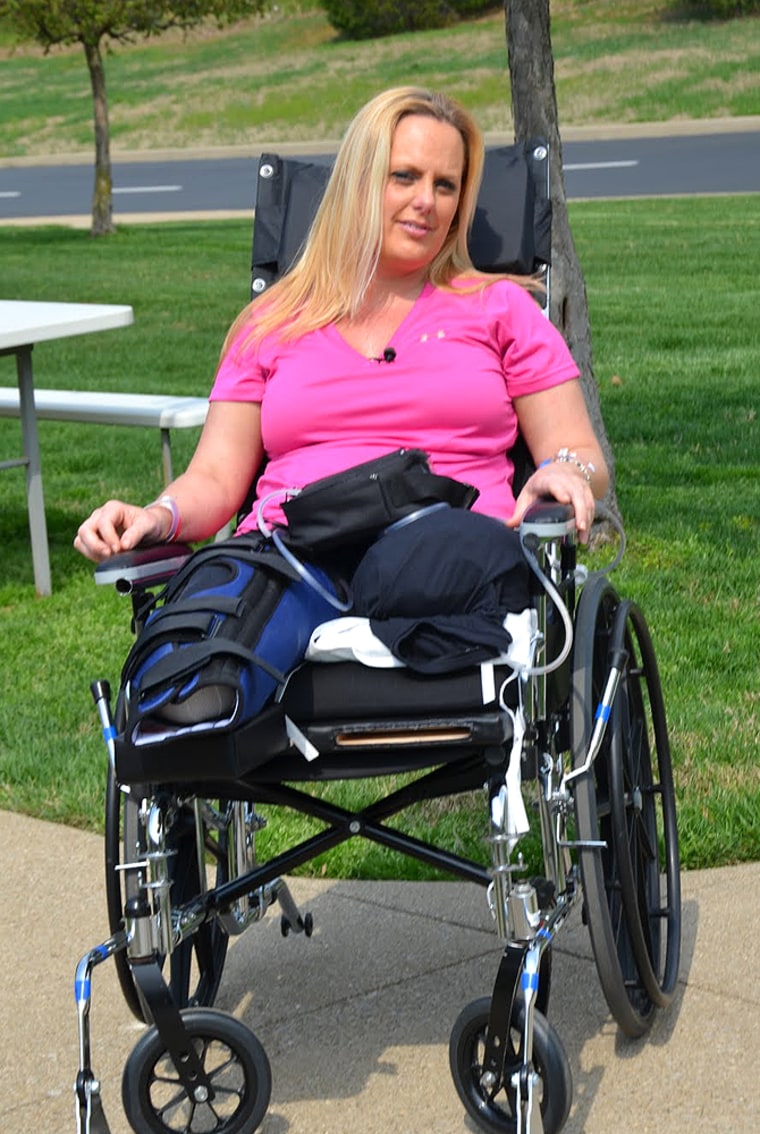After a tornado hit the Henryville, Ind., home of Stephanie Decker last year, injuring her so badly that both her legs had to be amputated, the 38-year-old mother of two knew she had to "push forward and thrive," she told NBC News. “If not only for myself, but also to show other amputees who have struggles of their own that the impossible is possible.”
Since that day in March 2012, Decker, known as "Tornado Mom," has become famous for her resiliency and spirit. She's now a motivational speaker and has created a foundation to help other amputees. But not all victims of trauma are able to bounce back as Decker has.
As the nation recovers from recent tragedies in Boston and Oklahoma, "resiliency" has become the buzzword for recovery, a promise to rebound made almost before the full emotional impact of a disaster has been absorbed. Studies have shown that the majority of trauma survivors do go on to lead happy, productive lives -- but not everyone.
Emerging research on the biology of resilience suggests a person’s ability to recover – or risk of spiraling into depression -- may depend on an elusive combination of early life experiences, genetics and brain chemistry. In fact, recovering from trauma or heartbreak is a far more complicated response than scientists once thought, says Dr. Farris Tuma, chief of the Traumatic Stress Research Program at the National Institute of Mental Health.
“This is the Holy Grail – to understand what makes people resilient,” Tuma said.
Social relationships, faith, health and financial stability are factors in resilience, while negative childhood experiences, such as trauma, abuse and chronic stress, can prime the body to react to both major hardship and everyday setbacks with the same degree of fear and panic.
Video: We have a "resilient spirit" says former Oklahoma governor
A threat to one’s livelihood can trigger physiological changes like a racing heartbeat and shortened breath. A key component of the brain’s stress response system, known as the hypothalamic-pituitary-adrenal axis (HPA), begins signaling the release of the stress hormone cortisol to help the body respond.
For many who experience trauma or chronic stress, this response doesn’t calm down after the danger passes and they remain hyper-sensitive to even the smallest stressors or reminders of a painful event.
For Cheryl Sharp, 55, rebounding didn't come easily. Mental illness in her family and personal health problems at any early age turned her into someone who was prone to bouts of rage at the time. “Anything that was threatening, I would explode,” said Sharp, who is now a senior advisor for trauma-informed services for the National Council for Community Behavioral Healthcare in Washington, D.C.
By age 6, Sharp -- whose mother had schizophrenia and could be both loving and erratic – had endured multiple surgeries for kidney and bladder defects. She abused drugs and alcohol for several years. She first attempted suicide at age 13 and would try to take her own life eight more times before turning 24 and beginning what she calls a “journey to recovery.” Based on symptoms she exhibited at the time, Sharp was diagnosed with an array of disorders: schizophrenia, borderline personality disorder, bipolar disorder, major depressive depression disorder.
Sharp, who occasionally used medication, also relied on supportive relationships with nonjudgmental friends who had similar experiences with mental illness. Eventually, with the aid of cognitive behavioral and emotional release therapy over several years, Sharp’s life changed dramatically.

She manages her recovery with a program called Wellness Recovery Action Plan (WRAP), which focuses on a daily maintenance plan of simple tasks that improve mood, how to identify emotional triggers and how to handle an emotional crisis.
“Some of us are born with greater resilience than others, but it can also be learned, nurtured and developed,” she said. “A person can rebuild [a] difficult moment as a strength and recognize they’re more than their losses or experiences.”
Scientists are just now beginning to understand how traumatic early-life experiences can alter how genes are expressed. A developing field of study, known as epigenetics, examines how environmental factors like stress and parental attachment can turn genes regulating the brain’s stress response system on or off.
Although research has identified genes that indicate a predisposition to resiliency or vulnerability to trauma, Tuma said scientists have to increasingly account for the possibility that environmental influences at critical developmental periods, like infancy and early childhood, may also play a significant role.
Scientists aren’t sure yet whether the effect is universal, if it’s permanent, or if an antidepressant or a technique such as meditation could reverse it.
Neuroscientist Dr. Eric Nestler, director of the Friedman Brain Institute at the Icahn School of Medicine at Mount Sinai in New York City, believes environmental impact on genes partly explains why people respond differently to adversity.
Nestler’s lab has tested stress responses and epigenetic changes in mice. In one study two-thirds of the mice began to avoid other mice and became obese, less adventurous and less interested in activities like sex and eating sweets. Their brains showed modifications to genes that control the stress response.
The remaining mice, however, showed signs of resilience. The study also found mice could be made resilient when changes to certain genes were blocked. Nestler believes that these findings help us better understand the stress response, and what it might mean for humans coping with trying circumstances. While some patients carry on, he said, there are subsets with depression, PTSD, social anxiety and drug addiction.
“The challenge is if you look at the people subjected to these horrendous life events,” he said, “while most people do OK…we have no understanding of why the same inputs lead to such a disparate outcome. Presumably, that is driven by different genetics and different epigenetics.” Social and cultural factors, Nestler said, also play an important role.
Dr. Tallie Z. Baram, a neurobiologist at University of California, Irvine, has studied how resiliency or vulnerability is shaped in early life. She has found that consistent nurturing parental care in rodents silences a gene that activates a key part of the body’s stress response system.
“If the gene is repressed, that lowers your gear or the rev, so you are less sensitive to stress and therefore less vulnerable to stress-related disorders,” Baram said.
While rodent studies don’t prove the same causal relationship in humans, a similar effect is possible, experts believe.
Baram suspects that when the gene is turned on in humans, it leads to vulnerability that can be triggered by a traumatic event or chronic stress. This dynamic, she said, might explain why the onset of depression or suicidal thoughts often strikes in adolescence.
It’s not yet possible, however, to detect these change in the brains of patients. Scientists at the National Institute of Mental Health are developing brain-imaging technologies to visualize the chemical markers that attach to genes, but there is not yet a practical biomarker or tool that could be used in a clinical setting.
Such tools might help scientists understand how someone like Decker, the mom who became an amputee, was able to recover. She never experienced post-traumatic stress, she told NBC News.
“I want [my kids] to understand everyone struggles and everyone has a story," she said. "It’s how you deal with your story is what makes the difference in your life.”
She credits her father’s lessons about the importance of hard work and her college years as a competitive athlete as being key to helping her get through a year of grueling physical therapy and rehab without crumbling.
Tuma believes epigenetic research is “vital” to understanding why patients have such different responses to trauma. Where a slow or difficult recovery might have once been seen as a personal weakness, it’s now being understood as a matter of how environmental factors can change our biology.
Doctors may eventually be able to identify the “biological signature” of a psychological disease or condition and offer tailored treatments. In the meantime, Tuma said, just knowing how the body responds to trauma and stress is a powerful weapon in the fight to thrive again.
Rebecca Ruiz is a reporter based in Oakland, Calif. This story was produced with the support of a Rosalynn Carter Fellowship for Mental Health Journalism.
